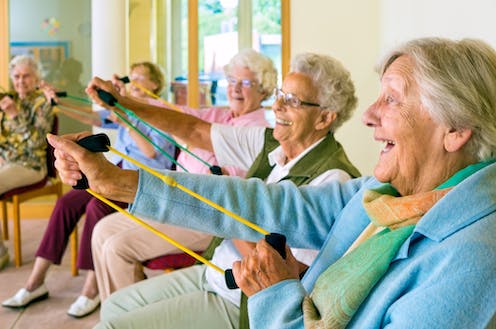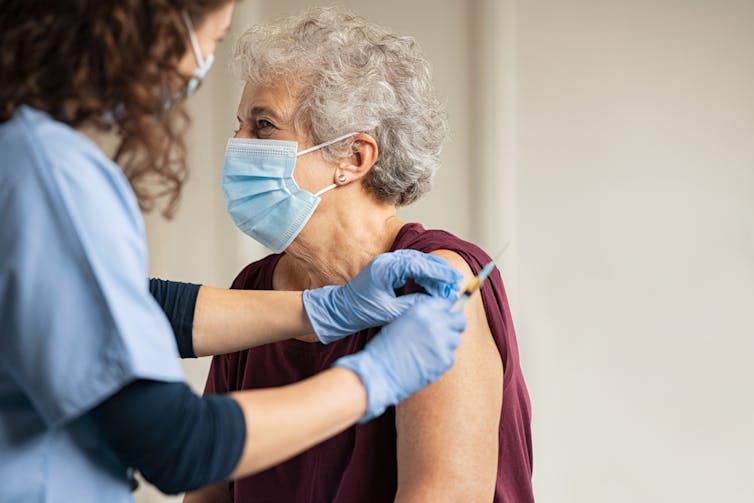As Australia heads towards the fourth winter of the pandemic, we have once again started seeing an increase in the level of COVID circulating. With this comes an increased risk of infection and serious illness.
Elderly people living in aged care are one of the groups facing the greatest risk.
But the latest figures from the federal health department show that to May 24 just over 40% (42.9%) of aged care residents estimated eligible for a booster vaccination have had their latest shot and are fully vaccinated.
If we also take into account immunity gained through recent infection in the past six months, just over half (50.4%) of aged care residents are estimated to have adequate levels of immunity.
Although numbers have increased considerably in the past few weeks, this is plainly far from ideal.
It’s been heartbreaking
Earlier in the pandemic, I was briefly part of the Victorian Aged Care Response Centre, set up to coordinate the response to the COVID surge in residential facilities. I was part of the team that collected, collated and interpreted COVID data used to inform the public health response.
What we witnessed in aged care then, and since, has been nothing short of heartbreaking.
Our inability to adequately protect aged care residents in the early part of the pandemic was undoubtedly one of our biggest pandemic failures.
I saw firsthand that this was not due to a lack of effort. The reality was there were just too many factors thwarting our ability to bring outbreaks under control in this uniquely challenging setting.
Since then, aged care residents have continued to die from COVID during the Omicron era. Since January 2022 COVID has accounted for about 5% of all deaths in residential aged care.
Why booster shots are so critical
Maintaining high levels of immunity by being up to date with COVID boosters is vital for protecting this vulnerable cohort from serious outcomes this winter.
Age, existing chronic illnesses and weaker immune systems are just some of the reasons why this group is most vulnerable.
Not only do vaccines protect against severe illness, they reduce the likelihood of passing COVID on to others in this high-risk environment.
And with higher rates of COVID transmission in the community, we’ll likely see more active outbreaks in residential aged care facilities. This highlights how important it is to see more residents receive their booster shots.
Age, existing chronic illnesses and weaker immune systems are just some of the reasons why elderly people need to have their COVID booster shots. Shutterstock
COVID fatigue, vaccine distribution
It’s not entirely clear why COVID booster rates in aged care are so low.
There may be some COVID vaccine fatigue. Residents and their families may have tuned out to public health messages about the importance of vaccination and keeping up to date with booster shots. But how much of an issue this is in aged care is hard to measure.
Changes in the way COVID vaccines are delivered to aged care may have also played a role. Early in the pandemic, vaccine delivery was coordinated federally. However, now aged care centres are responsible for ensuring residents have access to the recommended COVID vaccine, with primary health-care providers, such as GPs and pharmacists, administering the shots.
We’ve tried incentives
Health departments and health workers are well aware of the need to adequately protect aged care residents as we head towards winter.
In February 2023, incentive payments for eligible health workers to go into residential aged care facilities to administer COVID vaccines were streamlined and increased.
In April 2023, the federal health department’s chief medical officer, and the aged care quality and safety commissioner issued a joint letter to aged care providers with advice on preparing for winter, including a reminder about COVID vaccination.
The federal government has also called on Primary Health Networks – bodies responsible for coordinating delivery of primary health care in their regions – to encourage them to support residential aged care homes across Australia to arrange COVID vaccination clinics.
This is all positive and sensible. Yet, we still haven’t seen a huge spike in COVID booster rates as we reach the end of May. That is concerning.
We mustn’t forget flu vaccines
As we enter the colder months, influenza also poses a significant threat for aged care residents.
So promoting COVID and influenza vaccination in aged care should go hand-in-hand this year, and for the foreseeable future.



 Office design isn’t keeping up with post-COVID work styles - here’s what workers really want
Office design isn’t keeping up with post-COVID work styles - here’s what workers really want  Canada’s local food system faces major roadblocks without urgent policy changes
Canada’s local food system faces major roadblocks without urgent policy changes  Yes, government influences wages – but not just in the way you might think
Yes, government influences wages – but not just in the way you might think  Columbia Student Mahmoud Khalil Fights Arrest as Deportation Case Moves to New Jersey
Columbia Student Mahmoud Khalil Fights Arrest as Deportation Case Moves to New Jersey  The pandemic is still disrupting young people’s careers
The pandemic is still disrupting young people’s careers  Why financial hardship is more likely if you’re disabled or sick
Why financial hardship is more likely if you’re disabled or sick  The Beauty Beneath the Expressway: A Journey from Self to Service
The Beauty Beneath the Expressway: A Journey from Self to Service  The ghost of Robodebt – Federal Court rules billions of dollars in welfare debts must be recalculated
The ghost of Robodebt – Federal Court rules billions of dollars in welfare debts must be recalculated  What’s the difference between baking powder and baking soda? It’s subtle, but significant
What’s the difference between baking powder and baking soda? It’s subtle, but significant  Locked up then locked out: how NZ’s bank rules make life for ex-prisoners even harder
Locked up then locked out: how NZ’s bank rules make life for ex-prisoners even harder  The American mass exodus to Canada amid Trump 2.0 has yet to materialize
The American mass exodus to Canada amid Trump 2.0 has yet to materialize  Why have so few atrocities ever been recognised as genocide?
Why have so few atrocities ever been recognised as genocide?  Why a ‘rip-off’ degree might be worth the money after all – research study
Why a ‘rip-off’ degree might be worth the money after all – research study  Glastonbury is as popular than ever, but complaints about the lineup reveal its generational challenge
Glastonbury is as popular than ever, but complaints about the lineup reveal its generational challenge  Disaster or digital spectacle? The dangers of using floods to create social media content
Disaster or digital spectacle? The dangers of using floods to create social media content 

































